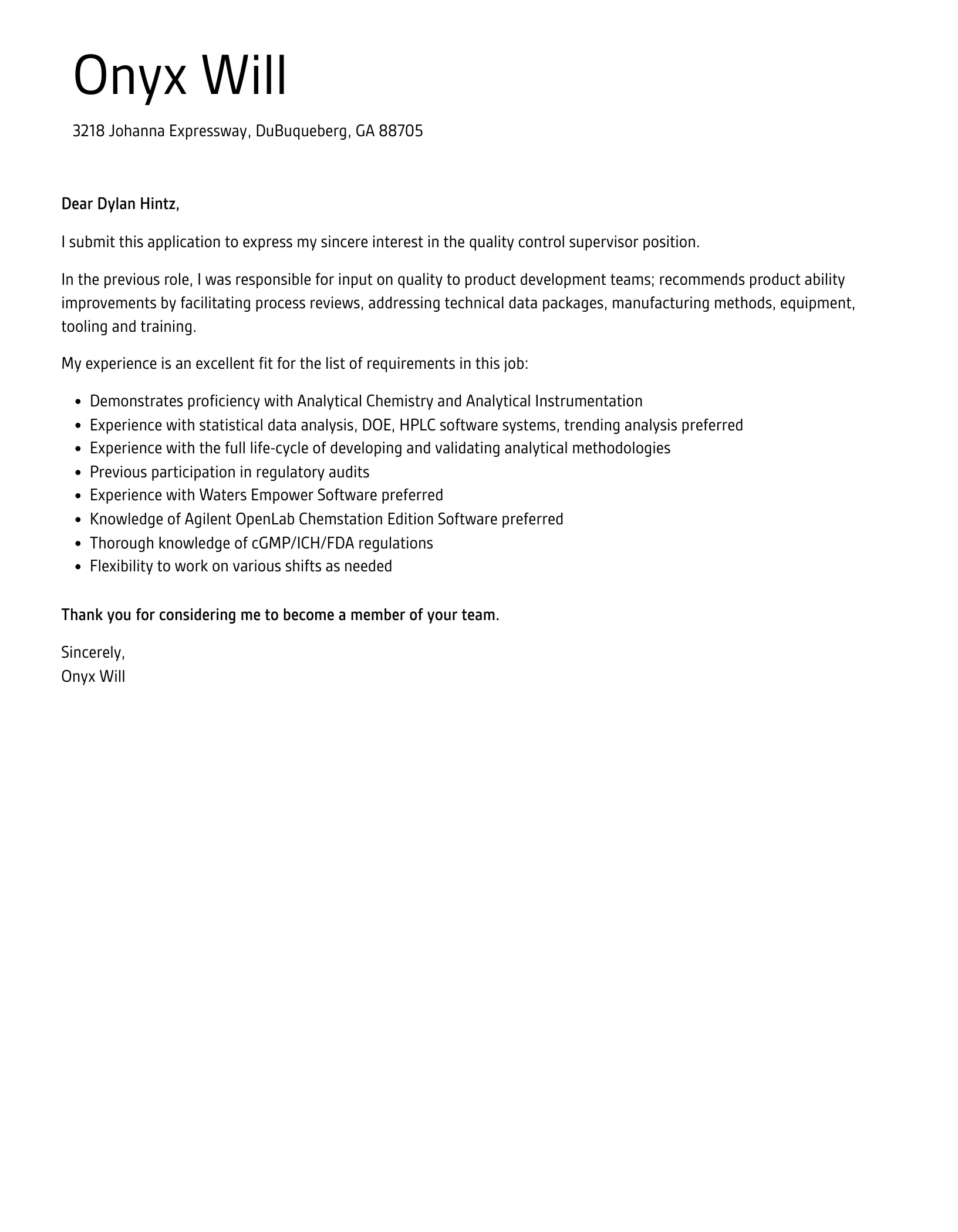Understanding the Importance of a Quality Control Cover Letter
In the competitive world of quality control, a well-crafted cover letter is your first opportunity to make a positive impression on a potential employer. It is more than just a formality; it’s a crucial tool that sets the stage for your job application. A compelling cover letter can significantly increase your chances of landing an interview, while a poorly written one can lead to your application being overlooked. This guide will provide you with the essential knowledge and practical advice to write a standout quality control cover letter that highlights your skills, experience, and enthusiasm for the role.
Why a Cover Letter Matters
A cover letter provides context to your resume. It allows you to explain your career goals, elaborate on your skills, and demonstrate why you’re a perfect fit for the specific quality control position. It showcases your personality, your communication skills, and your understanding of the company’s needs. It allows you to differentiate yourself from other applicants who may have similar qualifications. By presenting a clear narrative that connects your past experiences with the requirements of the job, you can make a strong case for why you should be considered.
Highlighting Your Quality Control Skills
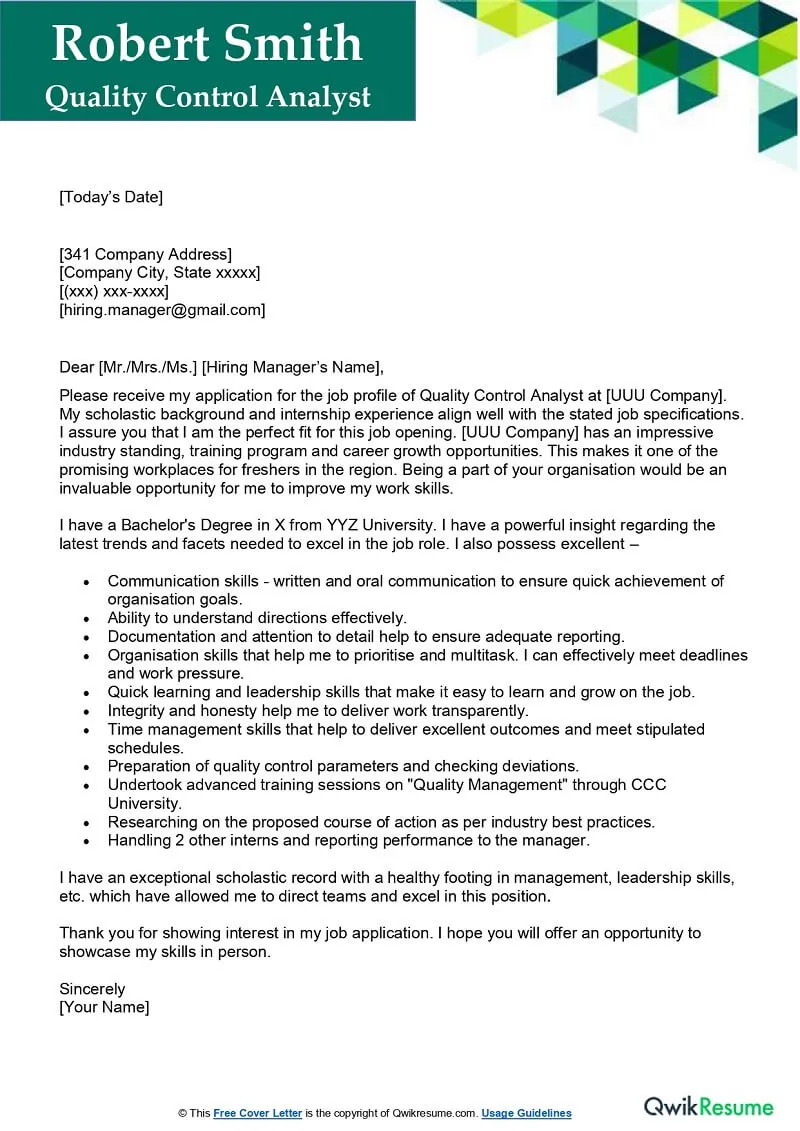
Your cover letter should be a showcase of your relevant quality control skills. These can include proficiency in inspection, testing methodologies, statistical process control (SPC), root cause analysis, and knowledge of quality management systems (QMS) like ISO 9001. When mentioning these skills, provide specific examples of how you’ve applied them in previous roles. For example, instead of simply stating you have experience with inspection, you could say, “I utilized various inspection techniques, including visual, dimensional, and functional testing, to ensure product adherence to specifications, resulting in a 15% reduction in defects.” This level of detail demonstrates your expertise and ability to deliver results. Quality control professionals need attention to detail, analytical skills, and the ability to identify and solve problems effectively. The cover letter is the perfect place to highlight these and more.
Key Components of a Quality Control Cover Letter
A well-structured cover letter follows a standard format. Each section serves a purpose and contributes to the overall impact of your letter. Adhering to this structure ensures that your letter is easy to read and that it conveys the necessary information effectively. Remember to tailor each section to the specific job and company to maximize your chances of success.
Contact Information and Date
Start with your contact information at the top left, including your name, address, phone number, and email address. Include the date below your contact information. This provides the employer with easy access to your contact details and indicates the date the letter was written. This is standard practice, but it’s a crucial detail that ensures professional presentation.
Recipient Information
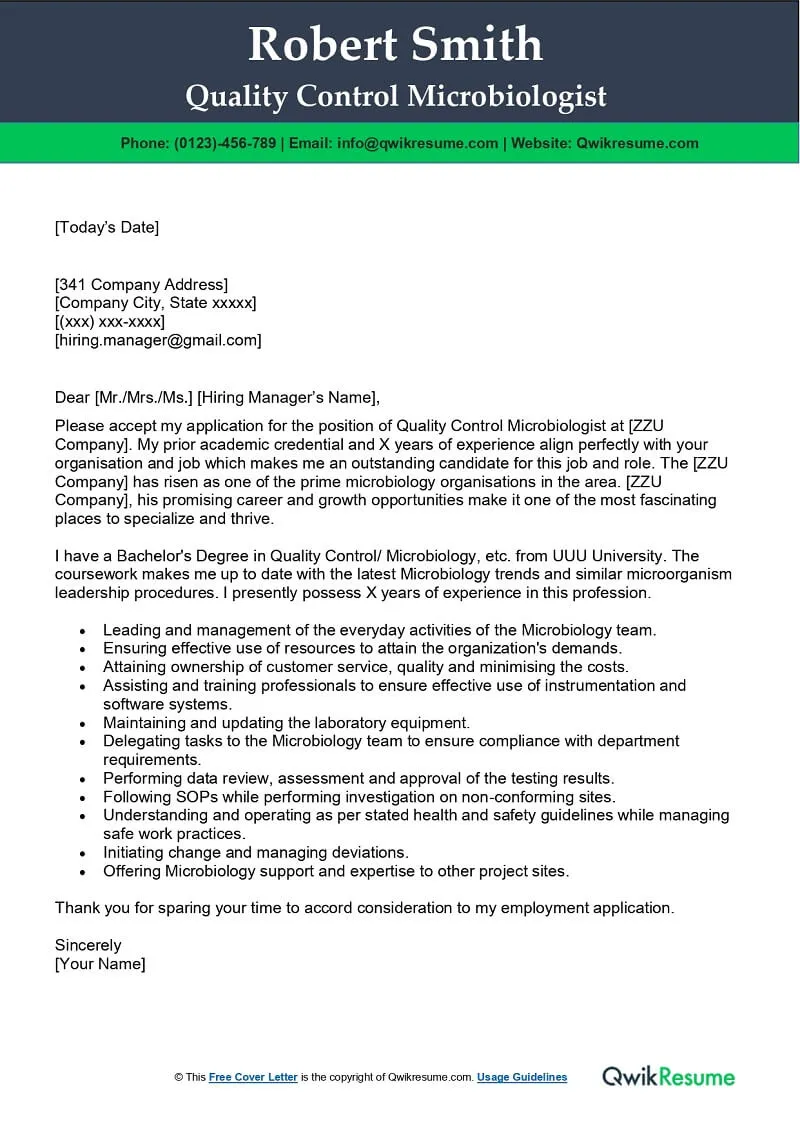
Address the letter to the hiring manager or the specific person listed in the job posting. If you can’t find a name, research the company to identify the appropriate person. Using a name personalizes your letter and shows that you’ve taken the time to learn about the organization. Always use the correct title (e.g., Mr., Ms., Dr.) and ensure that the spelling of their name is accurate. This detail demonstrates your attention to detail, a critical skill in quality control. If no name is available, you can use a general salutation like ‘Dear Hiring Manager’.
Salutation
Use a professional salutation such as “Dear Mr./Ms./Dr. [Last Name].” Avoid generic greetings like “To Whom It May Concern” if you have a specific contact person. A personalized salutation immediately establishes a connection and shows that you’ve done your research. If you are using “Dear Hiring Manager,” ensure your following paragraph is strong and addresses your interest in the specific role and company. Consider it an introduction, so to speak.
Writing a Compelling Opening Paragraph
The opening paragraph sets the tone for your entire cover letter. It should immediately grab the reader’s attention and make them want to continue reading. Clearly state the position you’re applying for and express your enthusiasm for the role and the company. Briefly mention how you learned about the opportunity. The opening should be concise, enthusiastic, and directly relevant to the job. Use a strong opening statement to capture the reader’s interest and demonstrate your understanding of the role.
Expressing Enthusiasm and Interest
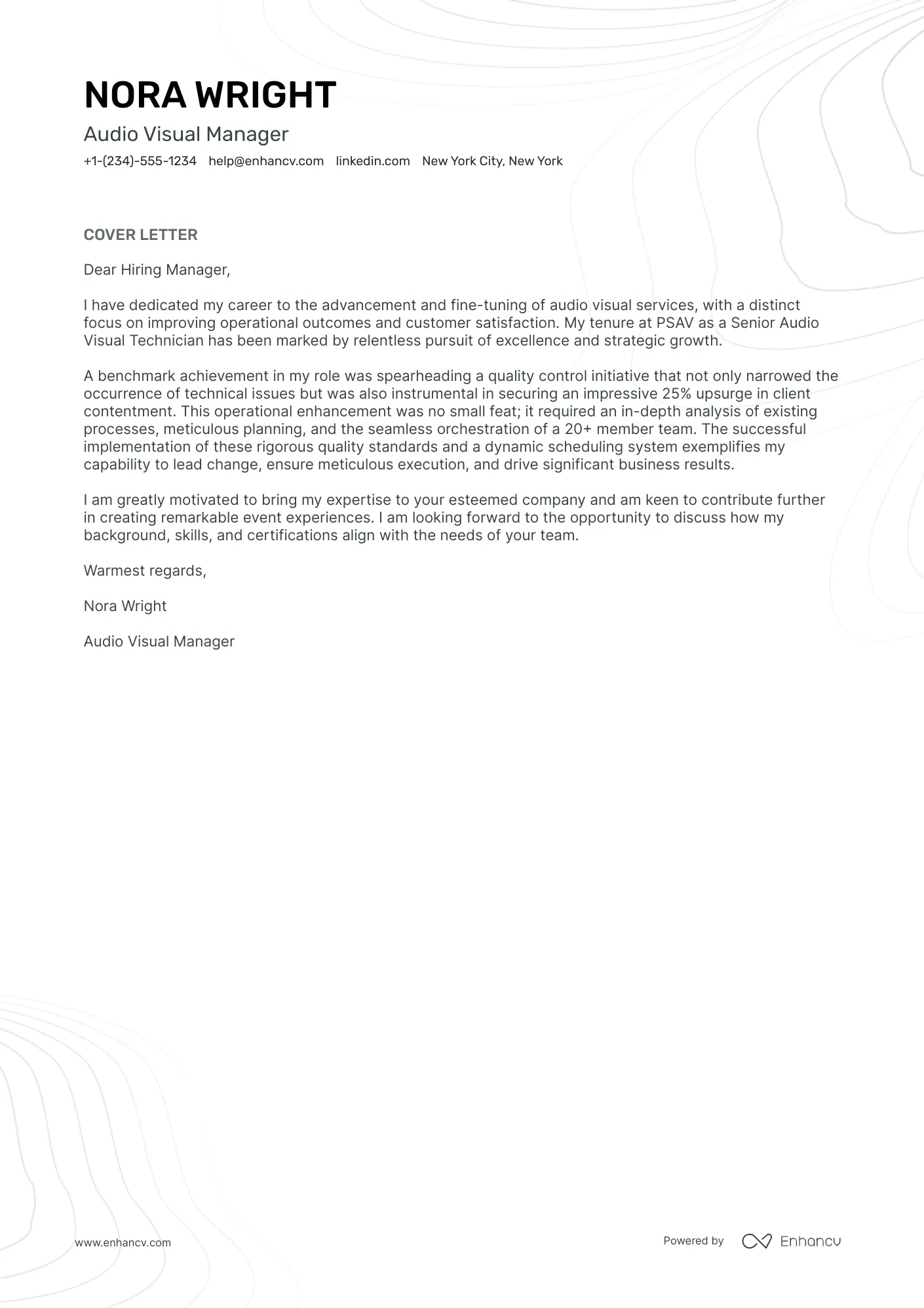
Show genuine excitement for the opportunity. Explain what interests you about the company or the specific role. If you are familiar with the company’s products, services, or mission, mention it. Your enthusiasm can be demonstrated by highlighting the company’s values, any particular projects you’re interested in, or industry trends that resonate with you. For example, instead of stating you are simply interested in a role, write something like: “I am excited about the opportunity to apply my skills in quality control to your innovative manufacturing process. My experience in…”
Mentioning the Specific Position
Clearly state the specific position you are applying for. Refer to the job title as listed in the advertisement. This clarity ensures that the hiring manager knows exactly which role you are interested in. Avoid generic statements, such as ‘I am writing to express my interest…’ Instead, state, ‘I am writing to apply for the Quality Control Inspector position…’ This demonstrates that you are attentive to details and understand the requirements of the application.
Showcasing Your Qualifications and Experience
This is the core of your cover letter, where you highlight your qualifications and relevant experience. Focus on the skills and experience that are most relevant to the job description. Use specific examples to demonstrate your abilities, rather than just listing your responsibilities. Quantify your achievements whenever possible to show the impact you’ve made in previous roles. The goal is to prove that you possess the skills and experience needed to succeed in the role.
Relevant Skills and Experience
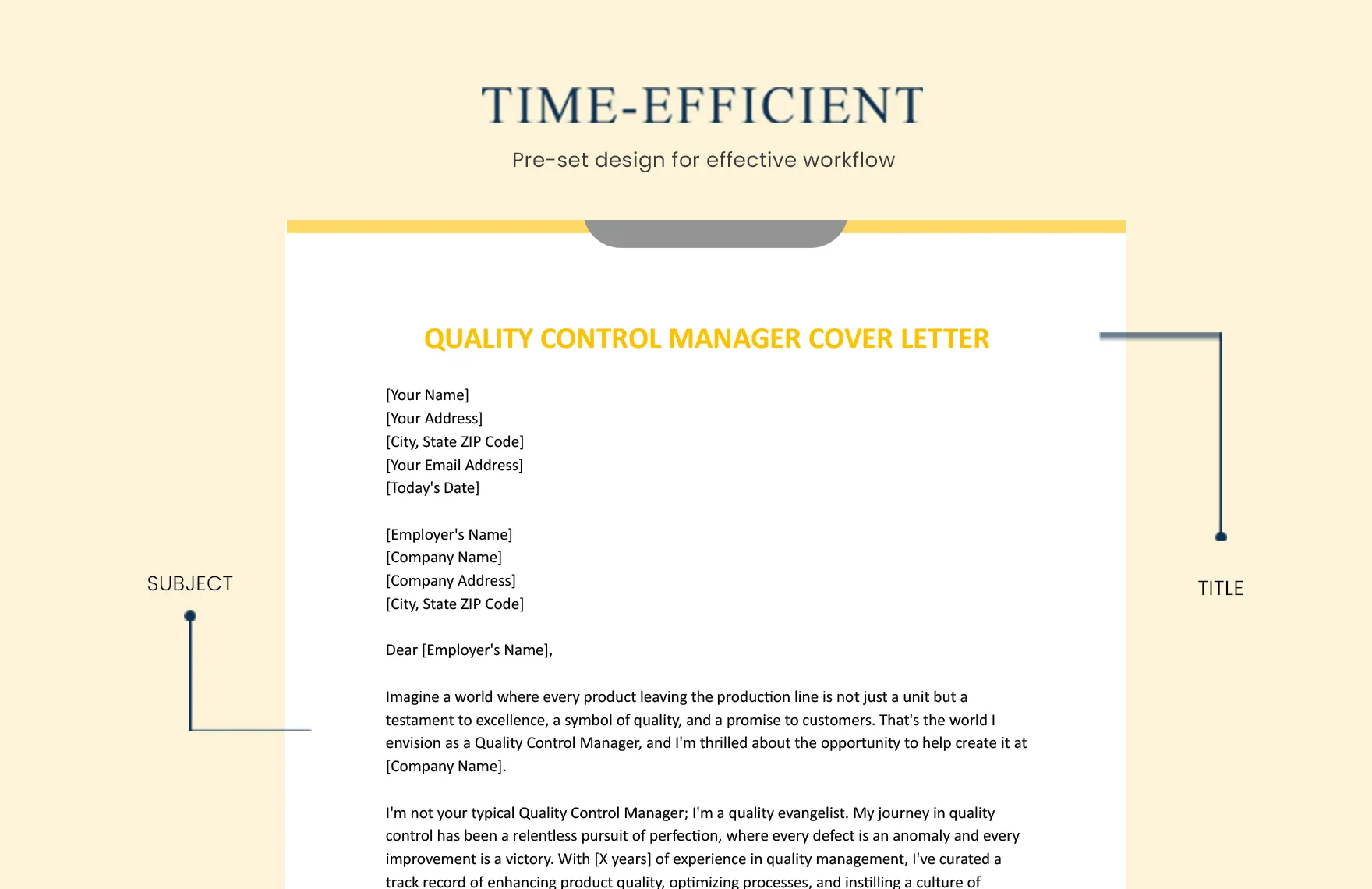
Select the most relevant skills and experiences from your resume. Use the job description as your guide and highlight the skills and experiences that align with the requirements. These may include inspection techniques, data analysis, problem-solving, and knowledge of industry standards. Describe how you’ve used these skills in previous roles to achieve specific results. Provide concrete examples. For example, “In my previous role at XYZ company, I implemented a new inspection process that reduced defect rates by 10%.” This is way more powerful than simply saying you have experience in inspection processes.
Quantifiable Achievements
Whenever possible, quantify your achievements. Use numbers, percentages, and specific data to demonstrate the impact of your work. For instance, instead of saying, ‘Improved efficiency,’ state, ‘Improved process efficiency by 15%.’ Use metrics such as defect reduction, cost savings, or time saved to showcase your accomplishments. Providing measurable results allows the hiring manager to see the value you bring to the table, and it distinguishes you from other candidates. This is one of the most effective ways to get your cover letter noticed.
Tailoring Your Letter to the Job Description
Never send a generic cover letter. Tailor each cover letter to the specific job description. This demonstrates that you’ve taken the time to understand the company’s needs and that you’re genuinely interested in the role. Customization shows your attention to detail and your ability to align your skills with the company’s requirements. The hiring manager will immediately know that you have carefully read the job posting and are a suitable fit.
Matching Keywords and Requirements
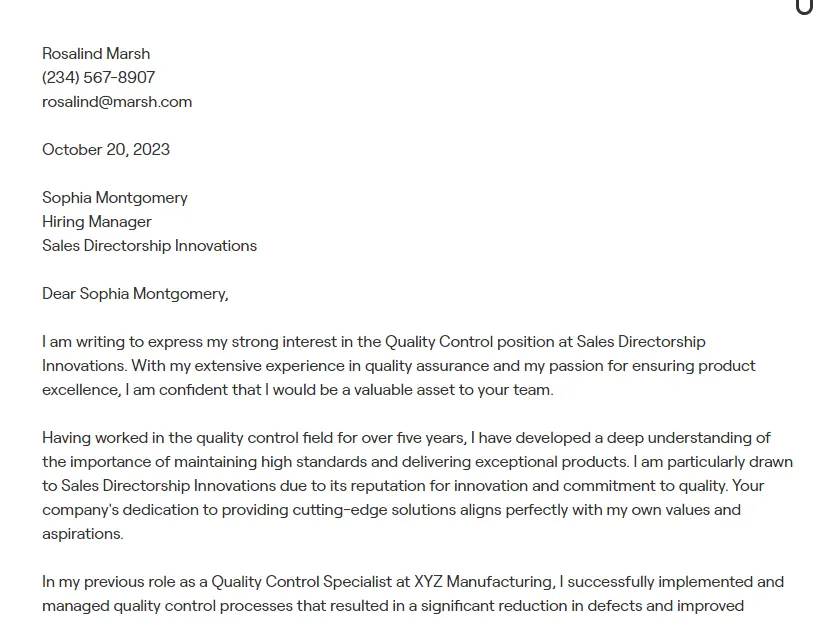
Carefully review the job description and identify the key requirements. Then, incorporate relevant keywords and phrases into your cover letter. This helps your application get noticed by applicant tracking systems (ATS) and ensures that your skills and experience align with the needs of the role. Make sure to use the keywords naturally, avoiding keyword stuffing, which can make your letter sound unnatural. Use keywords in the correct context to showcase your understanding of the role and company.
Demonstrating Knowledge of the Company
Research the company and demonstrate your knowledge of its products, services, and values. Mention specific projects or initiatives that resonate with you, showing that you’re genuinely interested in the company and what it does. This could involve citing their achievements, highlighting their commitment to quality, or mentioning a company value that aligns with your personal values. Demonstrating that you understand the company and its objectives makes you a more attractive candidate, because it shows that you’re going to fit in.
Crafting a Strong Closing
The closing paragraph provides a final opportunity to leave a positive impression and encourage the hiring manager to take action. It should reiterate your interest in the position, express gratitude for their time, and include a clear call to action. A well-crafted closing can significantly increase your chances of receiving an interview.
Reiterating Interest and Gratitude
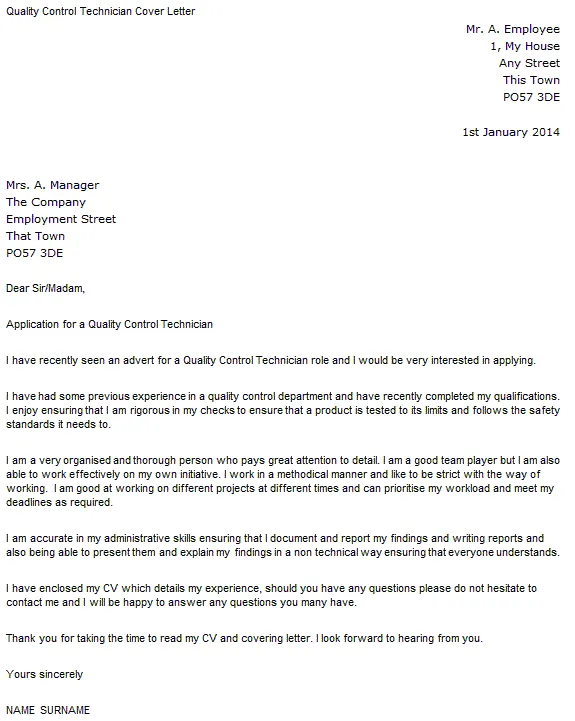
Restate your enthusiasm for the position and the company. Thank the hiring manager for their time and consideration. Expressing gratitude leaves a positive impression and shows that you value their time. Keep it concise and sincere, showing that you appreciate the opportunity to be considered for the role. Conclude with a strong statement reaffirming your interest.
Call to Action
End with a clear call to action. This can be a request for an interview or an offer to provide additional information. Make it easy for the hiring manager to take the next step. For example, “I am eager to discuss my qualifications further and am available for an interview at your earliest convenience. Thank you for your time and consideration.” A strong call to action encourages a response and moves your application forward.
Formatting and Proofreading
Formatting and proofreading are crucial for making a positive first impression. A well-formatted, error-free cover letter shows professionalism, attention to detail, and a commitment to quality. Ensure your cover letter is polished and easy to read. The appearance of your letter reflects the quality of your work.
Font and Readability
Choose a professional font that is easy to read, such as Times New Roman, Arial, or Calibri. Use a font size of 11 or 12 points for the body of your letter and 14 points for your name and contact information. Ensure your letter has clear formatting, with sufficient white space, and proper paragraphing. This makes your letter visually appealing and easy to navigate. Readability is essential, as the hiring manager should focus on the content of your letter, not on the formatting issues.
Proofreading for Errors
Proofread your cover letter multiple times. Check for spelling, grammar, and punctuation errors. Have someone else review your cover letter to provide a fresh perspective, as it is easy to miss mistakes when you’ve been working on it for an extended period. Typos and errors can damage your credibility and undermine your application. Pay close attention to detail, which is essential in a quality control role. A mistake-free cover letter demonstrates your commitment to quality.
Cover Letter Examples
Reviewing examples of cover letters can give you a practical understanding of how to structure your own. You can adapt the language and format to fit your skills and experience. Take a look at the examples below.
Example 1
This is a sample example, the goal here is to showcase structure: [Insert example]
Example 2
This is a sample example, the goal here is to showcase structure: [Insert example]
Example 3
This is a sample example, the goal here is to showcase structure: [Insert example]
Final Thoughts and Tips
Writing a compelling quality control cover letter takes time and effort, but the results are well worth it. By following the guidelines in this guide, you can create a cover letter that effectively showcases your skills, experience, and enthusiasm for the role. Remember to tailor your letter to each job application, proofread carefully, and always present yourself professionally. Good luck with your job search!
